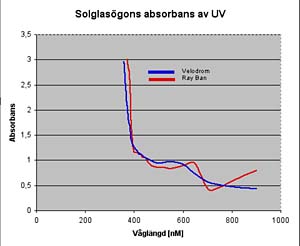
Most Velodrom glasses come in a choice of grey, yellow and brown lens. Why? And what does the CE certification “CAT1” or “CAT2” mean?
Not darker than necessary
All “sunglasses” of well-known brands sold by serious traders (stay vigilant when buying cheap glasses on the beach) protect against UV rays, and that is good. But it is important to understand that if the glasses are darker than necessary, it really will be just a zero-sum game with eye pupils, who will open behind the dark glass. The latter has several disadvantages. Your focus depth decreases, and IF any daylight leaks in from the sides of the glasses, the eyes can easily be damaged now when the pupils are wide open and let the unfiltered UV light right in.
On the inside of the temples of Velodrom glasses a CE marking is printed indicating how dark the glass is. Cat 1 or Cat 2. The higher the number, the darker the glass. Ordernary sunglasses often have Cat 3 or even darker. But I have concluded that motorcycle glasses shouldn’t be darker than Cat 2 to have a safe sight even if you ride into a tunnel or poorly lighted environment. Unnecessarily dark glass also makes it harder to see through the cover glass of your instruments. Cat 2 is therefore the darkest shade of Velodrom glasses (the gray and brown lenses). The yellow lenses are Cat 1—almost transparent to ordinary visible light. Lighter glass also means smaller pupil, which is part of the body’s natural defenses against harmful light.
Colour
We mentioned above that grey lenses, except for protecting against UV rays, don’t do much more than darken the view a bit. Brown or yellow lenses, on the contrary, help you see better by moving the light in a direction where the eye works better. And they attenuate that visible blue light that makes you squint your eyes. It is no coincident that sharpshooters use yellow lenses that sharpens contrasts, and that you give light-sentitive patients at eye clinics brown lenses after cataract surgery (actually red-brownish, just like the Velodrom Dayglow lens). This lens colour gives you eyes very calm “working conditions”. You see better, and your eyes stay alert longer time. You become a safer driver.
Rule of thumb: Yellow lenses CAT 2 are especially suitable in bad light conditions—at dusk or night, in rain or fog. CAT 2 lenses are good for all daylight conditions, also a bit into dusk when you wouldn’t see a thing with CAT 3 glasses. Stay away from the latter, they are just silly fashion. Unless you regularly inspect atmospheric nuclear tests or the like.
Bad glasses worse than no glasses at all
That yellow glasses are good is scientifically clear. Here, eye researcher Ulf Wihlmark at the University Hospital in Linköping talks about how the eye works with different colors on the glasses. Ulf Wihlmarks has researched the yellow spot in the retina of the eye and written a doctoral dissertation on the subject.
– Most people choose sunglasses according to the trend that applies to the season, Ulf Wihlmark begins in the interview, and continues:
– They’re mistaken. Instead of choosing a fashion color, we should look at what kind of light the glass filters out. The sun’s blue and ultraviolet rays are the most dangerous. When they hit the retina, the visual cells are damaged or die. The visual impairment that affects many older people is due to damage to the macula, where the eye’s sharp vision is located. When the macula is damaged, it is difficult to read and fix the gaze. With the right sunglasses, you can help prevent injury.
– In principle, blue and UV light are best filtered out with yellow glass. Blue glass lets through the dangerous light and thus becomes completely ineffective. Blue glass can be worse than no glass at all, as well as other glass that is dark but still lets in the harmful light. This is because the pupil is dilated by the dark glass, and lets in even more of the light that penetrates the glass into the eye. Gray and brown glasses also work better against the blue light.
UV light breaks down the yellow spot
About one-third of all people over the age of 70 suffer from visual impairment as a result of damage to the macula. The disease is called “macular degeneration”. It can be hereditary, but strong sunlight and smoking can also adversely affect the macula.
From a purely medical point of view, the following happens: UV rays hit the retina and convert the oxygen in the retina into free radicals. This causes the cells’ fats to turn rancid and a slag product is formed which the body cannot break down. The result is reduced visual acuity.
There is no known method to cure macular degeneration. With good sunglasses, however, you can prevent the disease. Velodrom glasses protect your eyes against this disease. Partly because the glasses are of good quality (polycarbonate which is naturally UV-filtering) and partly because the shape of the frames protects against light entry from the sides.
Below is a test of the UV protection in a pair of Velodromes compared to a pair of Ray-Ban. As can be seen, the glasses are completely comparable. The Velodrome curve is even smoother than the Ray-Ban.

